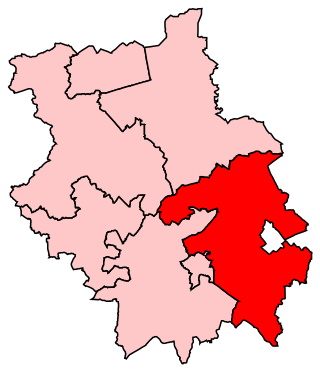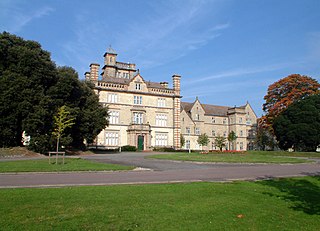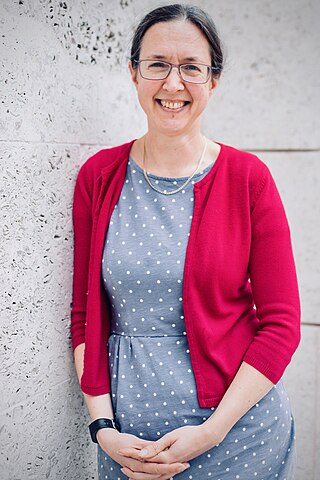Related Research Articles

The turbojet is an airbreathing jet engine which is typically used in aircraft. It consists of a gas turbine with a propelling nozzle. The gas turbine has an air inlet which includes inlet guide vanes, a compressor, a combustion chamber, and a turbine. The compressed air from the compressor is heated by burning fuel in the combustion chamber and then allowed to expand through the turbine. The turbine exhaust is then expanded in the propelling nozzle where it is accelerated to high speed to provide thrust. Two engineers, Frank Whittle in the United Kingdom and Hans von Ohain in Germany, developed the concept independently into practical engines during the late 1930s.

South East Cambridgeshire was a constituency represented in the House of Commons of the UK Parliament from 2015 to 2024 by Lucy Frazer, a member of the Conservative Party who has served as the Culture Secretary since 2023. The constituency was established for the 1983 general election and was based on the cathedral city of Ely.

A superalloy, or high-performance alloy, is an alloy with the ability to operate at a high fraction of its melting point. Key characteristics of a superalloy include mechanical strength, thermal creep deformation resistance, surface stability, and corrosion and oxidation resistance.

The Department of Materials at the University of Oxford, England was founded in the 1950s as the Department of Metallurgy, by William Hume-Rothery, who was a reader in Oxford's Department of Inorganic Chemistry. It is part of the university's Mathematical, Physical and Life Sciences Division

Fulbourn Hospital is a mental health facility located between the Cambridgeshire village of Fulbourn and the Cambridge city boundary at Cherry Hinton, about 5 miles (8 km) south-east of the city centre. It is managed by the Cambridgeshire and Peterborough NHS Foundation Trust. The Ida Darwin Hospital site is situated behind Fulbourn Hospital. It is run and managed by the same trust, with both hospitals sharing the same facilities and staff pool.

The Institute of Materials, Minerals and Mining (IOM3) is a British engineering institution with activities including promotion of the development of materials science.

The Department of Materials Science and Metallurgy (DMSM) is a large research and teaching division of the University of Cambridge. Since 2013 it has been located in West Cambridge, having previously occupied several buildings on the New Museums Site in the centre of Cambridge.
The A. A. Griffith Medal and Prize was awarded annually from 1965 to 2021 by the Institute of Materials, Minerals and Mining in commemoration of Alan Arnold Griffith.

Roger Charles Reed is a Professor of Engineering Science and Materials at the University of Oxford. He works at Oxford's Begbroke Science Park, and is associated with its Departments of Engineering Science and Materials. He is a Fellow at St. Anne's College, Oxford.

Thomas Benjamin Britton is a materials scientist, engineer and Associate Professor at The University of British Columbia. His research interests are in micromechanics, deformation, strain and electron backscatter diffraction (EBSD). In 2014 he was awarded the Silver Medal of the Institute of Materials, Minerals and Mining (IOM3), a society of which he then became a Fellow in 2016.
Aloke Paul is an Indian materials scientist and a professor at the Department of Materials Engineering of the Indian Institute of Science. Known for his studies on solid state diffusion, Paul is an Alexander von Humboldt Fellow. The Council of Scientific and Industrial Research, the apex agency of the Government of India for scientific research, awarded him the Shanti Swarup Bhatnagar Prize for Science and Technology, the highest Indian science award, for his contributions to engineering sciences in 2017.

Judith Louise MacManus-Driscoll is a Professor of Materials Science at the University of Cambridge. Driscoll is known for her interdisciplinary work on thin film engineering. She has a particular focus on functional oxide systems, demonstrating new ways to engineer thin films to meet the required applications performance. She has worked extensively in the fields of high temperature superconductors, ferroics and multiferroics, ionics, and semiconductors. She holds several licensed patents.
Ruth Cameron FInstP FIOM3 FREng is a British materials scientist and professor at the University of Cambridge. She is co-director of the Cambridge Centre for Medical Materials, where she studies materials that interact therapeutically with the body. Since October 2020 she has been joint head of the Department of Materials Science and Metallurgy at Cambridge.

Rachel Angharad Oliver is a Professor of Materials Science at the University of Cambridge and a fellow of Robinson College, Cambridge. She works on characterisation techniques for gallium nitride materials for dark-emitting diodes and laser diodes.
Alison Jean Davenport is the Professor of Corrosion Science at the School of Metallurgy and Materials, University of Birmingham.
Rachel Clare Thomson is a professor of Materials Science and Engineering, and Pro Vice Chancellor of Teaching at Loughborough University. She is known for her expertise in measuring and predicting the behaviour of materials for high temperature power generation, as well as the development of higher education and research programmes.

Marion McQuillan was a British metallurgist who specialised in the engineering uses for titanium and its alloys. She researched jet engine metals and was on the first team to research titanium for the Royal Aircraft Establishment Farnborough (RAE).

Professor David Knowles FREng FIMMM is Professor of Nuclear Engineering at the University of Bristol and Chief Executive of the UK's Henry Royce Institute for advanced materials research. From 2016 to 2019, he was the co-director of the South West Nuclear Hub, and Atkins Fellow. His work focusses primarily on understanding and modelling the degradation mechanisms in metallic materials and their interrelation with the structural integrity of rotating and static equipment in the energy sector.
Fionn Patrick Edward Dunne is a Professor of Materials Science at Imperial College London and holds the Chair in Micromechanics and the Royal Academy of Engineering/Rolls-Royce Research Chair. Professor Dunne specialises in computational crystal plasticity and microstructure-sensitive nucleation and growth of short fatigue cracks in engineering materials, mainly Nickel, Titanium and Zirconium alloys.
David Dye is a Professor of Metallurgy at Imperial College London. Dye specialises in fatigue and micromechanics of aerospace and nuclear materials, mainly Ni/Co superalloys, titanium, TWIP steel, and Zirconium alloys.
References
- 1 2 3 "Prof. Cathie Mary Fiona Rae — Rolls-Royce UTC". rrutc.msm.cam.ac.uk. Retrieved 29 November 2018.
- 1 2 "Catherine Rae | Royal Society". royalsociety.org. Retrieved 29 November 2018.
- ↑ "UK Research and Innovation Grants".
- ↑ "Engineering Atoms Inside the Jet Engine: The Great British Take Off". SciTech Connect. Retrieved 29 November 2018.
- 1 2 Rae, C.M.F.; Reed, R.C. (2001). "The precipitation of topologically close-packed phases in rhenium-containing superalloys". Acta Materialia. 49 (19): 4113–4125. doi:10.1016/S1359-6454(01)00265-8. ISSN 1359-6454.
- 1 2 "Cambridge Material Eyes" (PDF). Winter 2017. Retrieved 29 November 2018.
- 1 2 3 4 5 6 7 8 9 "Professor Catherine Rae | Fellows | Contact | Emmanuel College, Cambridge". emma.cam.ac.uk. Retrieved 29 November 2018.
- ↑ Rae, Catherine Mary Fiona (1982). Grain boundary migration. ox.ac.uk (DPhil thesis). University of Oxford. OCLC 863325081. Copac 12597699.
- 1 2 3 "Professor Cathie Rae | Royal Society". royalsociety.org. Retrieved 29 November 2018.
- ↑ "Search Patents - Justia Patents Search". patents.justia.com. Retrieved 29 November 2018.
- ↑ "Committees Eurosuperalloys". s550682939.onlinehome.fr. Retrieved 29 November 2018.
- ↑ "Times Higher Education Awards 2017 shortlist announced". Times Higher Education (THE). 7 September 2017. Retrieved 29 November 2018.
- ↑ "SuperAlloys 2016: Short Courses". tms.org. Retrieved 29 November 2018.
- ↑ "Structure and Properties of Materials Committee contacts | IOM3". iom3.org. Retrieved 29 November 2018.
- ↑ "OxMet Technologies – Portfolio". oxmet-technologies.com. Archived from the original on 30 November 2018. Retrieved 29 November 2018.
- ↑ "Council and committee meetings - Cambridgeshire County Council > Elections". cambridgeshire.cmis.uk.com. Retrieved 7 May 2021.
- ↑ "New District Councillor in Little Wilbraham - The Wilbrahams, Great Wilbraham, Little Wilbraham and Six Mile Bottom". The Wilbrahams, Great Wilbraham, Little Wilbraham and Six Mile Bottom. 11 May 2018. Retrieved 29 November 2018.
- ↑ "Cathie Rae for Fen Ditton & Fulbourn in the South Cambridgeshire local election". Who Can I Vote For? by Democracy Club. Retrieved 29 November 2018.